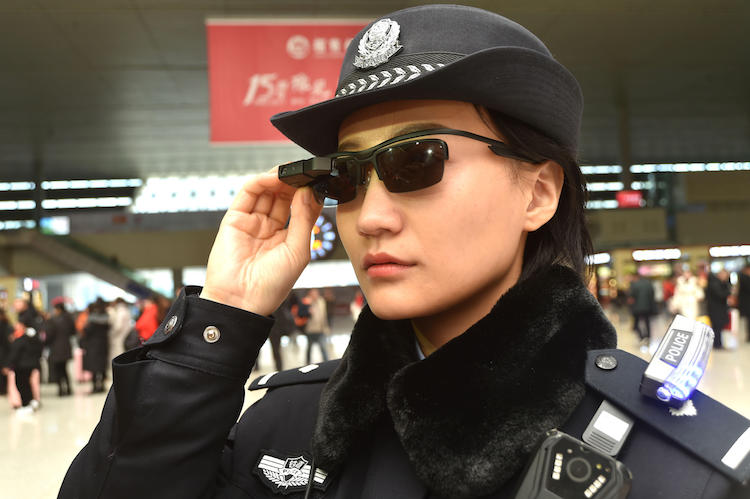Chinese police are already wearing the surveillance glasses of the future

Since the beginning of this month, China has been welcoming the New Year of the Dog with glasses worthy of Cerberus. Before and after February 16, 2018, according to local media, the massive human migration that takes place each year to celebrate this national family holiday will be subject to piercing surveillance by Chinese police wearing AR glasses equipped with facial recognition software.
Forget the techno-elitist failure of Google Glass, this year the spotlight is on Glxss, augmented reality (AR) glasses manufactured by the Beijing-based company LLVision Technology. These (sun)glasses, which incorporate a video camera, are already being deployed in the provinces of Henan, Shandong and Xinjiang, where police departments collaborated in their development, to identify individuals passing through major transport hubs in this peak holiday season.
This is not Google Glass, but facial recognition glass connected to Chinese police database. Deployed to a Zhengzhou railway station 5 days ago, it has detected at least 7 fugitives and 26 fake ID holders. #surveillance pic.twitter.com/eXrzRgORam
— FAN Wenxin (@xinwenfan) February 6, 2018
According to the CEO of LLVision, Wu Fei, as the Wall Street Journal reports, the facial recognition technology paired with the glasses was able to identify individuals from a database of 10,000 faces in one-tenth of a second during initial tests. But its real-life performance could be “a bit slower”. The system’s lightning speed, faster than most video camera surveillance systems (which are currently being trained to identify 1.3 billion Chinese in 3 seconds), is due to the fact that the glasses query an offline database that is stored on the paired device.
Chinese authorities estimate that up to 120,000 travellers pass through the main railway station in Zhengzhou, capital of Henan province, every day. Since the new Robocop glasses were deployed there in early February, patrolling police have reportedly identified and arrested 7 criminal suspects and 26 people travelling with fake documents.
China has a network of some 170 million surveillance cameras, with 400 million more cameras planned by 2020. The artificial intelligence of these systems uses deep learning to adapt and adjust to how faces evolve over time, while others will be trained to recognize individual gaits, for example. Chinese people can already use facial recognition to access buildings, board airplanes, withdraw cash, pay for their meal at KFC… But this technology has also been used to name and shame jaywalkers in Shanghai or to limit your ration of toilet paper at the Temple of Heaven in Beijing.
“In Your Face”, BBC report on “China’s all-seeing state” (Dec. 2017):
No doubt China is betting on the optimism of its citizens to implement these otherwise questionable measures. The South China Morning Post cites a recent survey revealing that 65% of Chinese believe that artificial intelligence and robotics will create more jobs… as opposed to 35% of French, 23% of Americans and 22% of Japanese. Because what good is big data if you can’t use it to better manage the population?
According to Wu Fei, LLVision has already sold basic models of Glxss (without facial recognition) to clients in Europe, the United States, Japan and Africa for 3,999 yuan ($630). He hasn’t yet set a price for the model that can recognize our faces…
